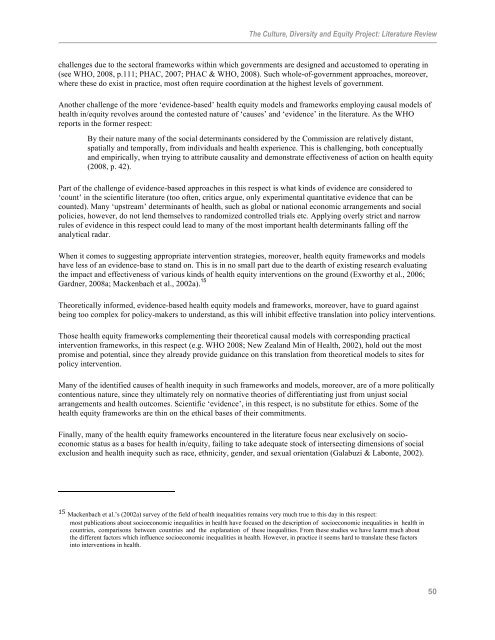CDE Appendix 1 Literature Review - Central East Local Health ...
CDE Appendix 1 Literature Review - Central East Local Health ...
CDE Appendix 1 Literature Review - Central East Local Health ...
Create successful ePaper yourself
Turn your PDF publications into a flip-book with our unique Google optimized e-Paper software.
The Culture, Diversity and Equity Project: <strong>Literature</strong> <strong>Review</strong><br />
challenges due to the sectoral frameworks within which governments are designed and accustomed to operating in<br />
(see WHO, 2008, p.111; PHAC, 2007; PHAC & WHO, 2008). Such whole-of-government approaches, moreover,<br />
where these do exist in practice, most often require coordination at the highest levels of government.<br />
Another challenge of the more ‘evidence-based’ health equity models and frameworks employing causal models of<br />
health in/equity revolves around the contested nature of ‘causes’ and ‘evidence’ in the literature. As the WHO<br />
reports in the former respect:<br />
By their nature many of the social determinants considered by the Commission are relatively distant,<br />
spatially and temporally, from individuals and health experience. This is challenging, both conceptually<br />
and empirically, when trying to attribute causality and demonstrate effectiveness of action on health equity<br />
(2008, p. 42).<br />
Part of the challenge of evidence-based approaches in this respect is what kinds of evidence are considered to<br />
‘count’ in the scientific literature (too often, critics argue, only experimental quantitative evidence that can be<br />
counted). Many ‘upstream’ determinants of health, such as global or national economic arrangements and social<br />
policies, however, do not lend themselves to randomized controlled trials etc. Applying overly strict and narrow<br />
rules of evidence in this respect could lead to many of the most important health determinants falling off the<br />
analytical radar.<br />
When it comes to suggesting appropriate intervention strategies, moreover, health equity frameworks and models<br />
have less of an evidence-base to stand on. This is in no small part due to the dearth of existing research evaluating<br />
the impact and effectiveness of various kinds of health equity interventions on the ground (Exworthy et al., 2006;<br />
Gardner, 2008a; Mackenbach et al., 2002a). 15<br />
Theoretically informed, evidence-based health equity models and frameworks, moreover, have to guard against<br />
being too complex for policy-makers to understand, as this will inhibit effective translation into policy interventions.<br />
Those health equity frameworks complementing their theoretical causal models with corresponding practical<br />
intervention frameworks, in this respect (e.g. WHO 2008; New Zealand Min of <strong>Health</strong>, 2002), hold out the most<br />
promise and potential, since they already provide guidance on this translation from theoretical models to sites for<br />
policy intervention.<br />
Many of the identified causes of health inequity in such frameworks and models, moreover, are of a more politically<br />
contentious nature, since they ultimately rely on normative theories of differentiating just from unjust social<br />
arrangements and health outcomes. Scientific ‘evidence’, in this respect, is no substitute for ethics. Some of the<br />
health equity frameworks are thin on the ethical bases of their commitments.<br />
Finally, many of the health equity frameworks encountered in the literature focus near exclusively on socioeconomic<br />
status as a bases for health in/equity, failing to take adequate stock of intersecting dimensions of social<br />
exclusion and health inequity such as race, ethnicity, gender, and sexual orientation (Galabuzi & Labonte, 2002).<br />
15 Mackenbach et al.’s (2002a) survey of the field of health inequalities remains very much true to this day in this respect:<br />
most publications about socioeconomic inequalities in health have focused on the description of socioeconomic inequalities in health in<br />
countries, comparisons between countries and the explanation of these inequalities. From these studies we have learnt much about<br />
the different factors which influence socioeconomic inequalities in health. However, in practice it seems hard to translate these factors<br />
into interventions in health.<br />
50

















